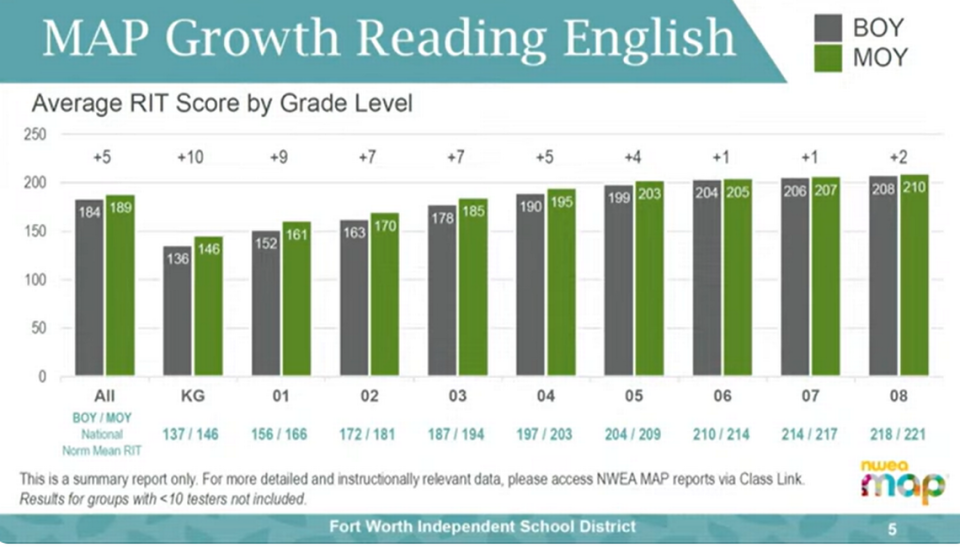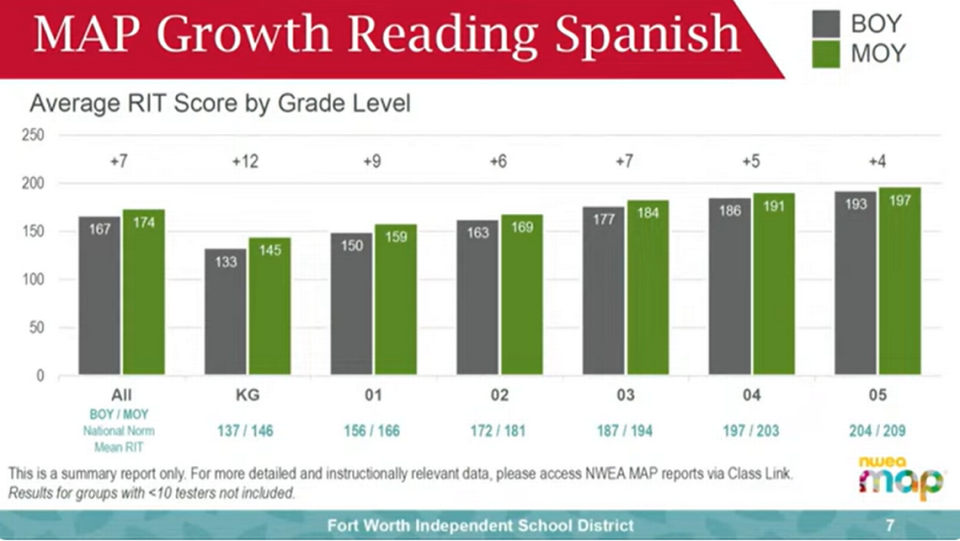Fort Worth ISD sees improvements in reading, math scores. Could gains translate to STAAR?
- Oops!Something went wrong.Please try again later.
Fort Worth Independent School District students saw gains in reading and math across kindergarten through eighth grade this school year — a bright spot that could signal continual growth as the district’s state test scores have fluctuated while attempting to rebound from COVID-19 learning gaps.
Superintendent Angélica Ramsey recently presented mid-year MAP exam scores at a school board meeting, highlighting progress in reading from kindergarten through eighth grade for English-speaking students while Spanish-speaking students saw gains from kindergarten through fifth grade. In math, progress was also seen from kindergarten through eighth grade. In both subjects, these gains also applied to Hispanic, African-American, white, emergent bilingual and special education students.
Although it remains to be seen whether this progress continues through the end of the school year, and how it might translate to improvements in future STAAR exam scores, district officials have a hopeful outlook on the mid-year data.
“These are not the type of reports that we’re used to giving, and so you can see even our staff out here… all smiles because all of the hard work that’s happening at our campuses is paying off,” Ramsey said, referring to district staff who attended the Feb. 13 meeting presentation.
“Congratulations to our students and our teachers. You’re seeing growth, we’re seeing the trajectory, and we’re also seeing that we’re not far off of the national mean,” Ramsey added.
MAP is a national exam that focuses on individual student growth and is taken by Fort Worth ISD students three times a year, according to Ramsey. In contrast, the STAAR exam, or the State of Texas Assessments of Academic Readiness, is taken at the end of the school year and measures what students are learning at each grade level. STAAR results are intended to show how well students are prepared to move on to the next grade, but kids aren’t held back if they don’t perform at grade level on the test.

The mid-year MAP scores could indicate a positive shift for Fort Worth ISD students, especially in reading assessments on the STAAR exam. The percentage of Fort Worth ISD’s third-graders last year who scored on grade level in reading was 32%, while 60% either approached or met grade level — a dip from the previous year when 38% met grade level and 66% either approached or met grade level.
Although district officials do not formally use MAP exams as a predictor for what STAAR test results could look like, MAP is used as a tool to help students catch up who are behind while also raising the ceiling for high achievers, according to Charles Garcia, an associate superintendent for the district.
“We have high hopes that we will continue to grow and we can’t predict, but it would be an implication of looking at what our STAAR scores will look like later on. Although I want to be very clear that it’s not intended to be a predictor of STAAR scores at all,” Garcia told the Star-Telegram.
The NWEA, the organization that administers the MAP exam, released a report in July 2020 that predicted students’ STAAR performance based on their MAP scores. The report focused on third- through eighth-graders and used spring 2017 data, which was updated to include 2020 data, to create a link between MAP assessments and STAAR performance levels.

“With this information, educators can identify students at risk of failing to meet state proficiency standards early in the year and provide tailored educational interventions. The linking study has been updated since the previous version published in December 2017 to incorporate the new 2020 NWEA MAP Growth norms,” the report reads.
A new study that takes into account the new format of STAAR, which was implemented last year, is expected to be completed “most likely later this spring,” according to an NWEA spokesperson.
Although the latest report states that a third-grade student with a MAP reading score of 200 in the winter is likely to meet proficiency on the STAAR reading test in the spring, critics of STAAR have pointed to studies that have found inconsistencies in the readability of test items and whether questions meet the intended grade levels. A 2019 study by Texas A&M University-Commerce professors determined that STAAR tests had difficulty levels one to two years ahead of the grade level being assessed in most cases.
The data provided by Ramsey shows that the current average MAP reading score for third-graders in the district is 185 while the current national average is 194. It remains to be seen whether the new format of STAAR, which includes more writing prompts and fewer multiple choice questions, will change these conversions calculated by NWEA.
Sarah Woulfin, an associate professor of educational leadership and policy at the University of Texas at Austin, said an updated “crosswalk” between the two tests could create a more reliable connection between MAP scores and STAAR scores, even as they serve different purposes.
“If we can do that crosswalk and say, if MAP scores are looking this strong in one particular district, whether it’s Fort Worth or another district, then we can see the bright spot and see the bright side and say, ‘It’s quite likely that we’re going to see gains (and) see some positive news from the STAAR results,” she said.
Woulfin also noted that districts’ investments in accelerated learning efforts and tutoring programs over the past couple of years after reopening campuses to students appears to show recovery from COVID-19 learning gaps.
Credit for Fort Worth ISD’s MAP exam improvements was attributed to additional learning programs, specifically Lexia reading programs and Dreambox math programs that have been utilized in recent school years through ESSER funding. The fund, known as the Elementary and Secondary School Emergency Relief fund, was approved by Congress in three iterations in 2020 and 2021 to help districts catch up on learning gaps and expires on Sept. 30 this year.
Garcia, the Fort Worth ISD associate superintendent, said district officials are discussing the financial potential of keeping these programs in place.
“Due to the fact that we have seen some gains, and we’re seeing the growth using these two supplemental support programs, we are in talks to ensure that we are solidifying the funding sources needed,” Garcia said. “As always, we go back to academic return on investment: Is it paying off for our kids, and what are the metrics that we’re using to ensure that that’s validated?”
Rebecca Sayman, a fifth-grade teacher at Glen Park Elementary School, said she had students who started “severely below grade level” in reading at the beginning of the school year who have caught up in a matter of months with help from the learning programs that are used in the classroom and at home. These students are “comprehending what they’re reading as students meeting grade level standards for the first time.”
“When I’m able to look at these reports, for both Lexia and Dreambox, it really breaks it down to such a level that I’m able to target those exact skills that each student needs… It really has revolutionized, I think, the way that ... teachers are able to track our students’ progress,” she said. “You really get to see just great leaps in their learning because they’re excited and their confidence builds.”

